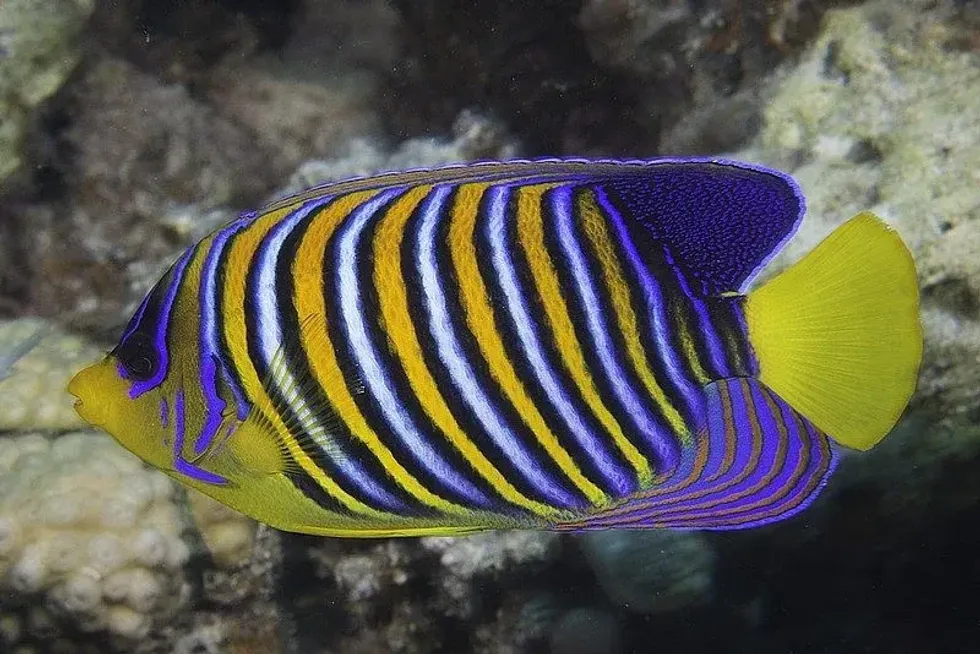The world under the ocean may make a person feel like they are in another dimension. The beauty of the coral reefs, the ocean bed, the aquatic flora, and fauna, all are kinds of therapy if one decides to take a trip underwater.
The ocean water, the sea is home to so many beautiful organisms with such striking appearances that may leave a person in awe. This fact file is about such an ocean dwelling creature, a regal angelfish (Pygoplites diacanthus), also referred to as the royal angelfish.
Native to the Indo-Pacific Ocean, a regal angelfish (Pygoplites diacanthus) dawdles in shallow waters amongst the corals and the underwater caves.
They feed on a carnivorous diet consisting of small aquatic crustaceans to algae and sponges. In an aquarium, they can be fed mysis shrimp, brine shrimp, and clams as well.
The regal angelfish was described first in 1772 by Pieter Boddaert, since then it has made its appearance in zoological arts of the 18th and 19th centuries. Scientifically a regal angelfish is known as Pygoplites diacanthus.
Here are some interesting facts about the regal angelfish (Pygoplites diacanthus) of the Indo Pacific for your perusal. Afterward, do check our other animal fact files on French angelfish and blue angelfish.
Regal Angel fish Interesting Facts
What type of animal is a regal angelfish?
The royal angelfish is an aquatic animal, a small to medium sized aquatic fish with a streamlined body and a pair of lateral fins, and a caudal fin. Pygoplites diacanthus, regal angelfish, is a colorful fish with alternate yellow, orange, blue or white strips with an outline of black and a pouty mouth.
This fish species is found in the Indian Ocean, Red Sea, and the Indo Pacific Ocean.
What class of animal does a regal angelfish belong to?
A regal Angelfish is an aggressive fish species belonging to the class Pisces of phylum Chordata and genus Pygoplites of kingdom Animalia. It further belongs to Pomacanthidae the family of perciform fishes and this family is a part of the order Actinopterygii, the members of which are all bony fishes.
The yellow blue stripes on the anal fin and blue dorsal fin with black scribbles add to the appearance of this fish species from the Indian Ocean. Juveniles have a similar coloration to the adults.
How many regal angelfish are there in the world?
These fish has a stable population and are seen breeding in good numbers across their natural habitat in the Indian Ocean, Red Sea, and the Indo Pacific Ocean. The exact count of the breeding population of this fish species is not really known.
This fish species is also referred to by many names such as empress angel fish, royal empress angel fish, and banded angel fish due to the presence of alternate colored bands on its body.
Where does a regal angelfish live?
A royal angel fish is found in shallow ocean waters of the Indo Pacific Ocean from the Red Sea to East Africa and all the way up to Tuamotu Islands, Great Barrier Reef and Ogasawara Islands at a maximum depth of 80 ft (25 m).
What is a regal angelfish's habitat?
It wanders between the coral reefs and sponges feeding on them and hides from the predators in the underwater caves. They are also kept in captivity in aquariums and fish tanks in domesticated environments.
Who do regal angelfish live with?
Most of these aggressive marine creatures are spotted living solitarily but they are also found in pairs. Between the natural coral reefs, these marine animals are also seen moving in small groups of two or more females and one male regal angelfish.
In the aquariums, they are also kept with other docile fishes and are observed as very social specimens.
How long does a regal angelfish live?
These fishes generally fall prey to larger aquatic fishes and mollusks. In the wild waters, they may have a life span of around 10 years or less but in captivity, with good conditions, they are observed to enjoy a generally longer life.
The longest lifespan recorded for a regal angelfish is around 15 years in aquariums if the tank size is correct.
How do they reproduce?
In the ocean, the courtship display takes place between male and female regal angelfish after the sunset along the Indo Pacific region. The breeding process lasts for around 25 minutes.
When both the adults are ready for mating, the female angelfish raises her pelvic and dorsal fins and directs them towards the male fish, who gets behind her and nuzzles her belly in a particular T shape, this is not their general posture.
After rising in a spiral fashion about a meter from the ground they release their gametes for fertilization. A protective layer generally covers the spawn to shade them from Zooplanktivoroes.
What is their conservation status?
Regal angelfish is considered a species with Least Concern required in terms of conservation efforts by the IUCN. The population of adults is generally stable for now but a threat is imposed on the existence of the regals by the increasing pollution of the ocean water bodies and decreasing coral reefs and sponges which constitute their natural habitat region.
Regal Angelfish Fun Facts
What do regal angelfishes look like?
A regal angelfish can grow from small to medium size. These are colorful fishes with alternate yellow or orange and white banding patterns on their body.
These bands have a shade of black and blue on their edges. When seen in the wild the patterns on their body may appear like a maze. These fishes have a bony endoskeleton and a scaly exoskeleton.
A pair of fins on the wither side of their body for swimming, a streamlined body, and a caudal fin for swift motion through water are a few general features. Juveniles have the same coloration as present in adults.
How cute are they?
Regals are really cute and appear as if they are pouting. They are docile, social and in a well kept environment, they appear very friendly too. The alternate banding patterns on the body of these marine animals are a major source of attraction.
How do they communicate?
These fishes are not really vocal but have their own way of communicating. Regals may communicate via vibrations produced in the waterbody and also respond to bioluminescence and electrical impulses produced in the body. Angelfish have a well developed nervous system that enables them to use their senses properly.
How big are regal angel fishes?
The Pygoplites diacanthus grows twice the size of an average goldfish. They may grow up to a length of 8-12 in (20.32-30.48 cm) on average.
How fast can a regal angelfish swim?
Fishes in general are swift creatures. A regal angelfish can swim swiftly in the water on sensing danger. They move really fast away from the predators. Their speed is not really known but is fast swimmers that are for sure.
How much does a regal angelfish weigh?
On average a regal angelfish may weigh around 4 lb (1.81 kg). Their medium sized and streamlined body is the reason for their lightweight.
What are the male and female names of the species?
Male and female regal angelfish do not have any separate names and are referred to by the same name. A distinguishing feature of a male and a female angelfish is that the females have a more rounded body and are smaller in size than the male fish.
What would you call a baby regal angelfish?
Regal angelfish baby fishes are known as juveniles until they reach one year of age. Juveniles usually take shelter in crevices and cracks along the coral reef.
What do they eat?
In the Indian Ocean, regal angel fish species like feeding on small sized crustaceans, aquatic worms, tunicates, shrimps, and small sized aquatic arthropods, algae, and sponges. In captivity to entice them for feeding, you can mysis shrimp, brine shrimp, and clams as well.
These fishes are sometimes bullied by bigger fishes and are eaten up by larger fishes.
Are they dangerous?
These are not really dangerous. They are docile animals and do no harm unless they are threatened. But when they are threatened they run away and hide in shelter and do not attack back.
Would they make a good pet?
The beautiful and exotic coloration of their exoskeleton, the beautiful banding pattern are all reasons to take them as pets. In a well kept aquarium where they are fed well they live for a longer period of time, hence they make really good pets.
Did you know...
A minimum tank size of 120 gallons (450 L) is ideal for the regal angelfish or royal angelfish.
Healthy specimens of a regale angelfish can survive in incorrect aquarium environments and can also feed on frozen diets.
Angelfish have the ability to recognize their owners. These fishes can remember a human face for months or even years at a time and form a bond with their human owners.
What is the rarest angelfish?
A black phantom angelfish are also known as Chaetodontoplus melanosoma is the rarest type of angelfish. It is a marine ray finned fish and is found in the western Pacific Ocean.
Gray angelfish is the largest angelfish that may grow up to a length of 24 in (60 cm). Gray angelfish are good to eat for humans and are consumed as both fresh and salted.
Are regal angelfish Reef Safe?
Saltwater tanks inhabiting coral and reefs along with friendly fishes that get along with the made environment are reef safe. In a reef safe environment, regal angelfishes adapt well.
They feed on the missy shrimps and clamps. Japanese swallowtail angelfish is one example of the angelfish species that do not harm corals and vertebrates in a reef safe and get along with them.
Here at Kidadl, we have carefully created lots of interesting family friendly animal facts for everyone to discover! For more relatable content, check out these fat sleeper facts and flamboyant cuttlefish facts pages.
You can even occupy yourself at home by coloring in one of our angel fish coloring pages.









